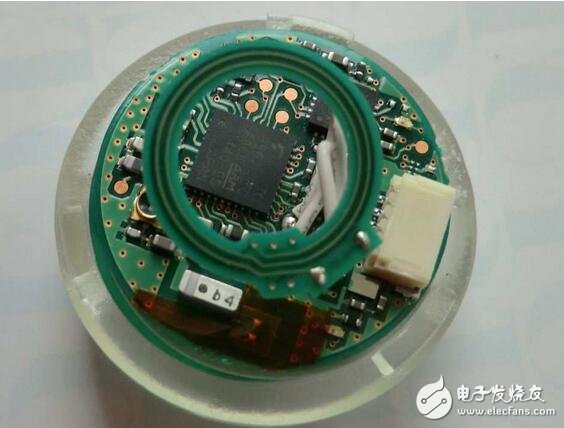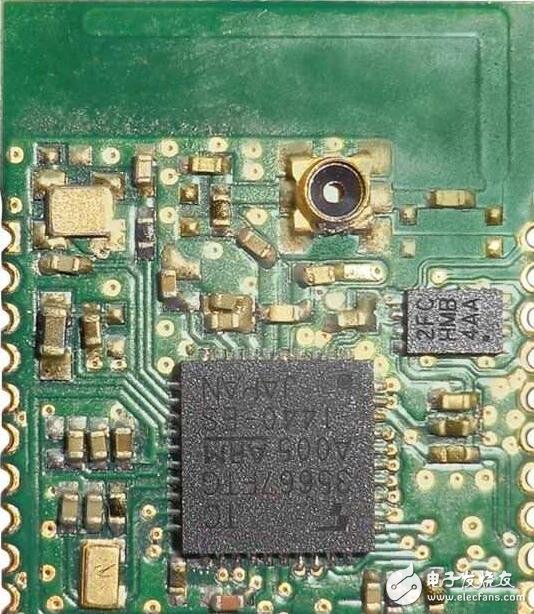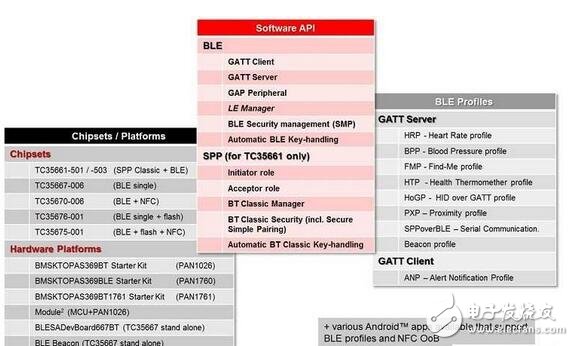Bluetooth Low Energy (BLE) technology creates many new application opportunities for designers through wireless applications that support ultra-low power operation, especially combining the advantages of Near Field Communication (NFC) technology.
There are currently two areas of application that are generating increasing interest in the market – secure extra-frequency (OoB) pairing and near-field applications based on the BLE Internet of Things (IoT) system concept. This article will explore these two areas and consider how to use the latest semiconductor technology and support tools to simplify the application of these two areas of application.
Bluetooth Low Energy Technology & Near Field CommunicationBluetooth Low Energy (BLE) technology is an energy-efficient, friendly application Bluetooth technology developed for IoT. The Bluetooth SIG improved its low-power technology and released BT version 4.2 in December 2014. New features include enhanced data encryption, support for Internet Protocol (IP), and faster version 4.1. speed. Bluetooth 5, with further enhancements, is also expected to be available by the end of 2016.
The advantages of traditional Bluetooth are communication range, ubiquity and low cost of construction. BLE clearly offers lower power consumption, which is an ideal solution for mobile and wearable platforms that dominate the IoT and are powered by button batteries.
Modern devices such as smart phones have adopted BLE technology as standard equipment. In addition, NFC technology has gradually been added. NFC's application areas include payment, access control, and security-related areas where Bluetooth communication may be maliciously intercepted by third parties. This is the so-called "Man in the middle" (MITM) phenomenon.
NFC offers a very different wireless communication path than Bluetooth. First, NFC involves a distance of up to 100 mm. Second, the amount and type of data that can be transmitted is limited and highly controlled, depending on the embedded NFC security scheme. In contrast, Bluetooth can transmit a variety of data types within a range of up to 100m.
OoB provides secure pairingCombining the security of NFC with the open communication of Bluetooth will bring substantial benefits. Bluetooth uses AES-128 encryption to effectively prevent eavesdropping or decrypting captured packets. However, using NFC to improve activities such as pairing will improve both safety and ease of use.
Since the NFC requires the device to be in an approximate position, the problem of the MITM is avoided, and the connection of the device that is not approved or permitted by the user is prevented. The specific method is to transmit a security key for pairing information, so-called OoB pairing, and only in a limited NFC range. NFC pairing is simple and straightforward and usually requires only a brief contact between the two devices.
NFC tags reduce IoT power consumptionFor example, a smart meter that is manually read every few weeks or months. The meter's connection circuitry may remain completely powered down until the operator turns the NFC reader or NFC-enabled mobile device closer to the 'tag'. The initial energy of the wake-up meter is provided by the NFC antenna, meaning that the BLE device may remain in deep sleep mode to ensure that the minimum power consumption is minimized, because the BLE IoT node does not check the communication request without long-term operation. 'broadcast'. When the credibility of the reading device is established, the connection can be established using BLE.
OoB pairing implementationAlthough the first feeling of this operation can be complicated, in fact, pairing and communication are quite simple and intuitive. Moreover, both NFC and Bluetooth "play their advantages."
First, the mobile device is placed close to the NFC device, for example, by tapping the smartphone or tablet with a payment terminal or printer (if in an office environment). For example, in a device equipped with a Toshiba TC35670 BLE + NFC tag wafer, the power from the NFC antenna in the mobile device will 'wake up' the fixture and securely transmit its Bluetooth authentication via NFC.
When the mobile device detects that a fixed device is present, a pairing request is sent through the NFC. The user does not have to check and enter a numeric string to confirm that the device in the pair is correct. This secure transmission mechanism prevents the security key from being intercepted by the 'intermediate' inadvertently or maliciously.
After the pairing is completed, the two devices can start AES-128 encrypted secure Bluetooth communication for data transmission. The mobile terminal may enable the application based on the NFC data content.

*Figure 1: Combining BLE and NFC design, using Toshiba TC35670 BLC+NFC tag chip, Bluetooth and NFC antenna*
New evolution application: BeaconUsing NFC's near-field detection function and then transmitting information securely through BLE, a new application can be derived, one of which is the Beacon. Beacon is extremely low power, low complexity, and provides simple data for near field devices (and users). Beacon can be used in many indoor applications such as promotion, navigation, building management and asset management. When Beacon completes the location, nearby App users will benefit from the micro-location notifications they send when they open the app.

Figure 2: Beacon enables targeted marketing and many other valuable commercial uses
In general, Beacon is a very low power device that is typically powered by a small button battery and must be able to be used continuously for weeks, months or even years. In a retail store, a customer can select a specific product via an app and obtain a guide to directly find a product, or push a special offer in a store to a customer. In the grocery store, Beacon can direct customers to get the items on the list in the most efficient way. In a business environment, Beacon-equipped assets can be easily tracked or located for safe and efficient operation and maintenance.
Beacon applications are almost unlimited. The marketing team dreams every day to develop new ways to use this technology. For example, in a stadium or a large theater, Beacon can guide consumers to find a seat or any location within the venue. Potential applications also include support for sales services, such as providing related merchandise and promotions, as well as tax refunds to assist with the purchase of merchandise.
BLE and NFC offer the possibility of new applications. Beacons are usually one-way devices that simply publish information such as URLs or locations. However, another application scenario may be to update the Beacon software and content over the BLE airstream, and trigger and protect through the NFC pairing mechanism. The process of connecting to Beacon via NFC tags is easier than pairing via Bluetooth, and it is more potentially secure because it blocks the interception of security information.
Development and implementation of Beacon technologyAs with most emerging technologies, competition for fast delivery of functional hardware and software to the market is also underway, with the goal of rapidly gaining market share in the early stages of adopting new technologies. One of the biggest challenges is the steep learning curve that many engineering teams face when building new technologies.
To help design teams quickly deliver fully functional Beacon technology to the market, the latest semiconductor technology and support tools help simplify design. For example, Toshiba is based on the reference design of the ultra low power BLE IC (TC35667) and BLE + NFC combined tag chip (TC35670). The reference design is a small module measuring only 17mm x 20mm, including the TC35667FTG, oscillator, EEPROM, built-in antenna and 1.27mm pitch test connection. When using the TC35670, connections to external NFC antennas are also provided. In broadcast, the peak power consumption is only 5.9mA; the module in deep sleep mode consumes very low power, only 0.1μA. The average power consumption depends on the selected broadcast period. At a 1 second period, its typical average power consumption does not exceed 30uA.

Figure 3: Development kit based on TC35667FTG, size approximately 17mm x 20mm
This reference design kit offers a variety of customer-oriented options. This includes changing the IC for the application to support BT 4.1 (TC35676) or BT 4.2 (TC35678), as well as built-in flash memory (to replace the external EEPROM). It also provides comprehensive support and documentation, including schematics, bill of materials, layout guides, Gerber files, and antenna patterns. In addition, modular solutions and programming development kits are available.
Toshiba also offers the Bluetooth Software Development Kit (SDK), a complete solution that simplifies the use of Toshiba's Bluetooth LSI while significantly reducing time-to-market. It supports multiple chipsets and platforms, including host-based stand-alone BLE systems, SPPover BLE profiles, and BLE + NFC combo functions. The software API supports the BLE GATT server and client, as well as the GAP center & peripheral functions.

Figure 4: The SDK is a multi-functional tool based on the prior art.
Beacon's configuration can now be configured to match any standard without having to do too many design tasks. The designer simply specifies the data format in the data array and then compiles a separate function caller to configure the beacon. Then compile the standard C++ debugging environment, execute the SDK code, and finally execute the Beacon technology. For example, by combining Toshiba's SDK, you can easily integrate any available Beacon standards, including Apple's iBeacon, Radius Networks' AltBeacon, and Google Eddystone.
Aluminum Electrolytic Capacitors/ Ceramic Capacitors
Aluminum Electrolytic Capacitors/ Ceramic Capacitors
Aluminum Electrolytic Capacitors,Electrolytic capacitor,Ceramic Capacitor
YANGZHOU POSITIONING TECH CO., LTD , https://www.yzpstcc.com